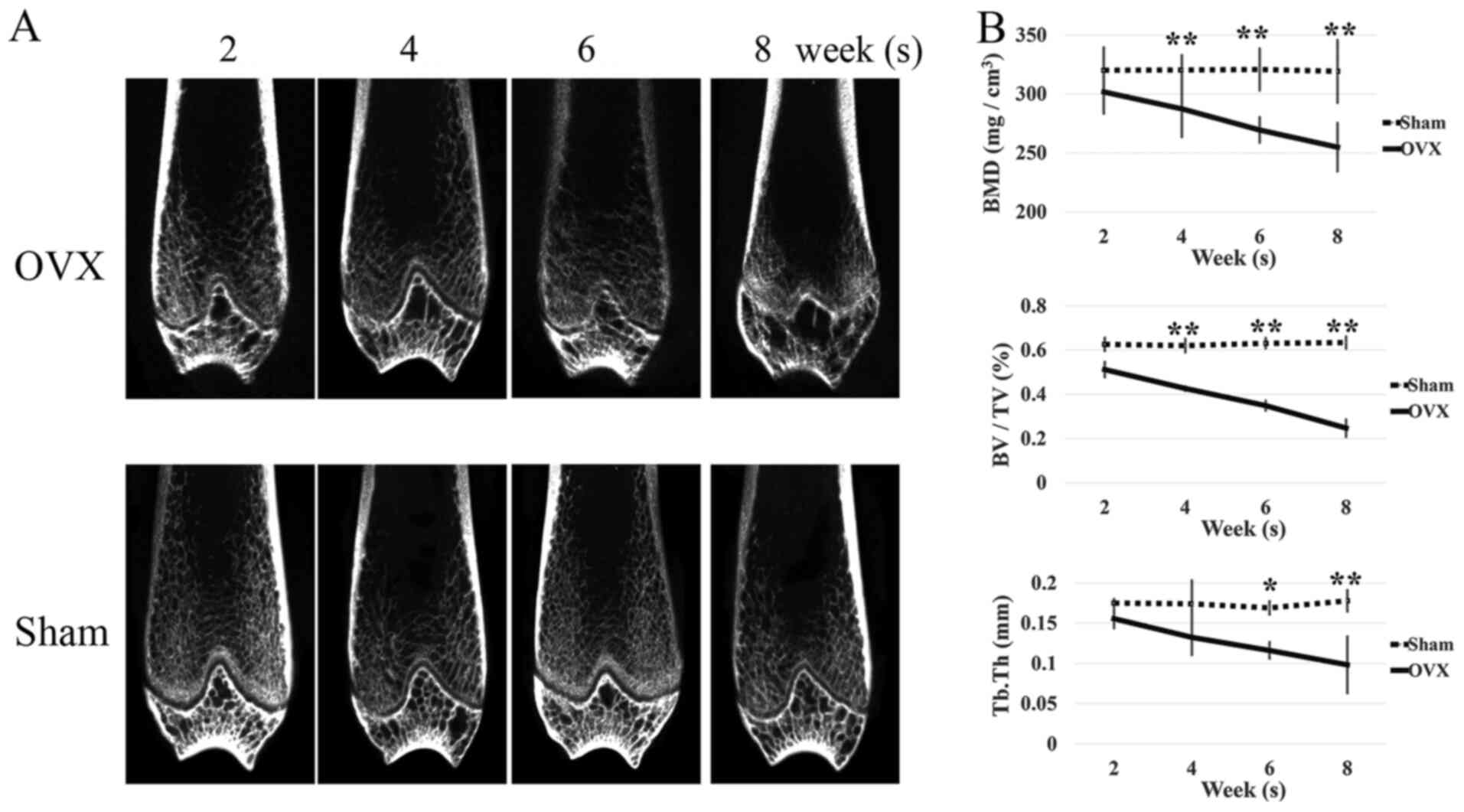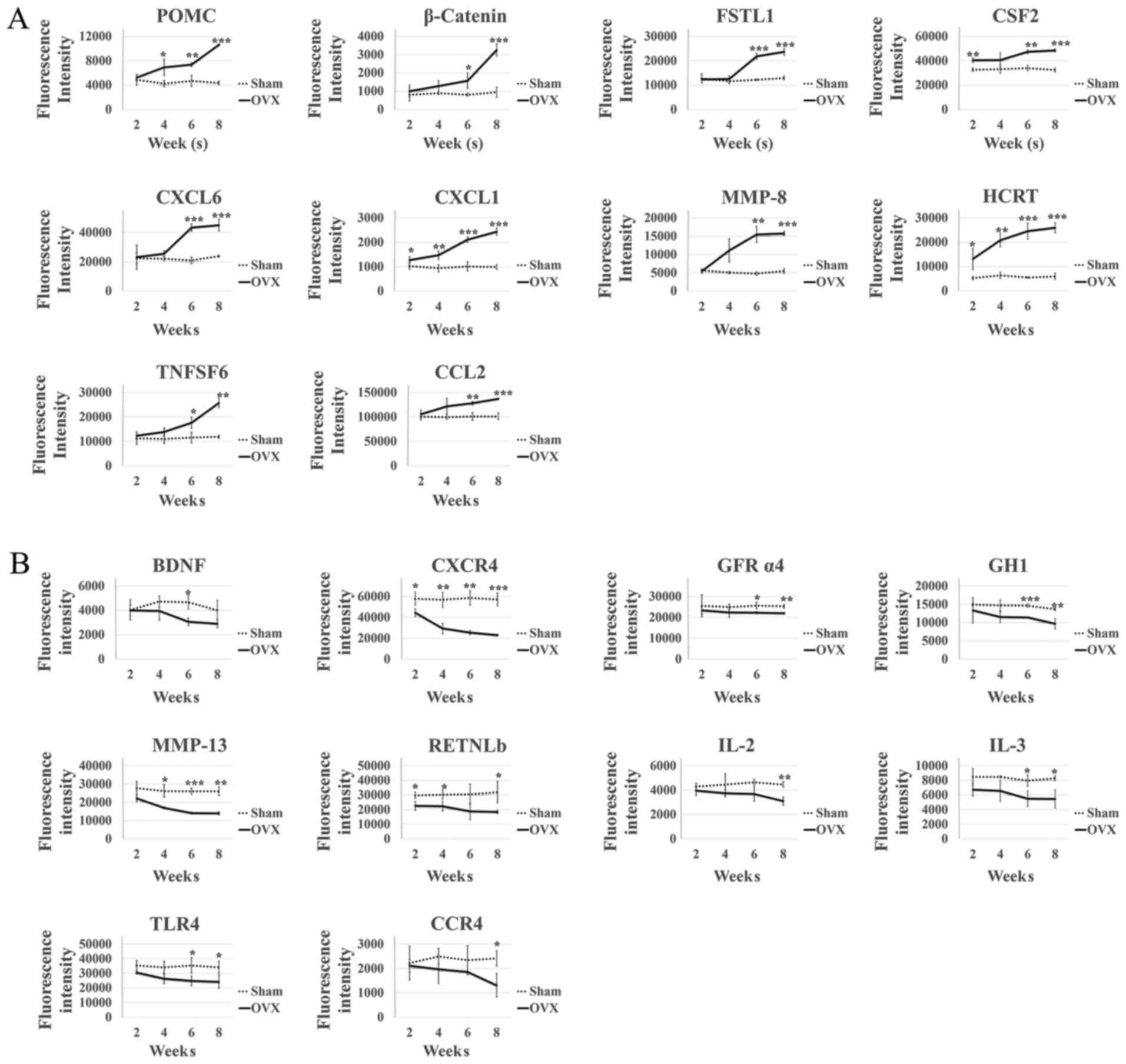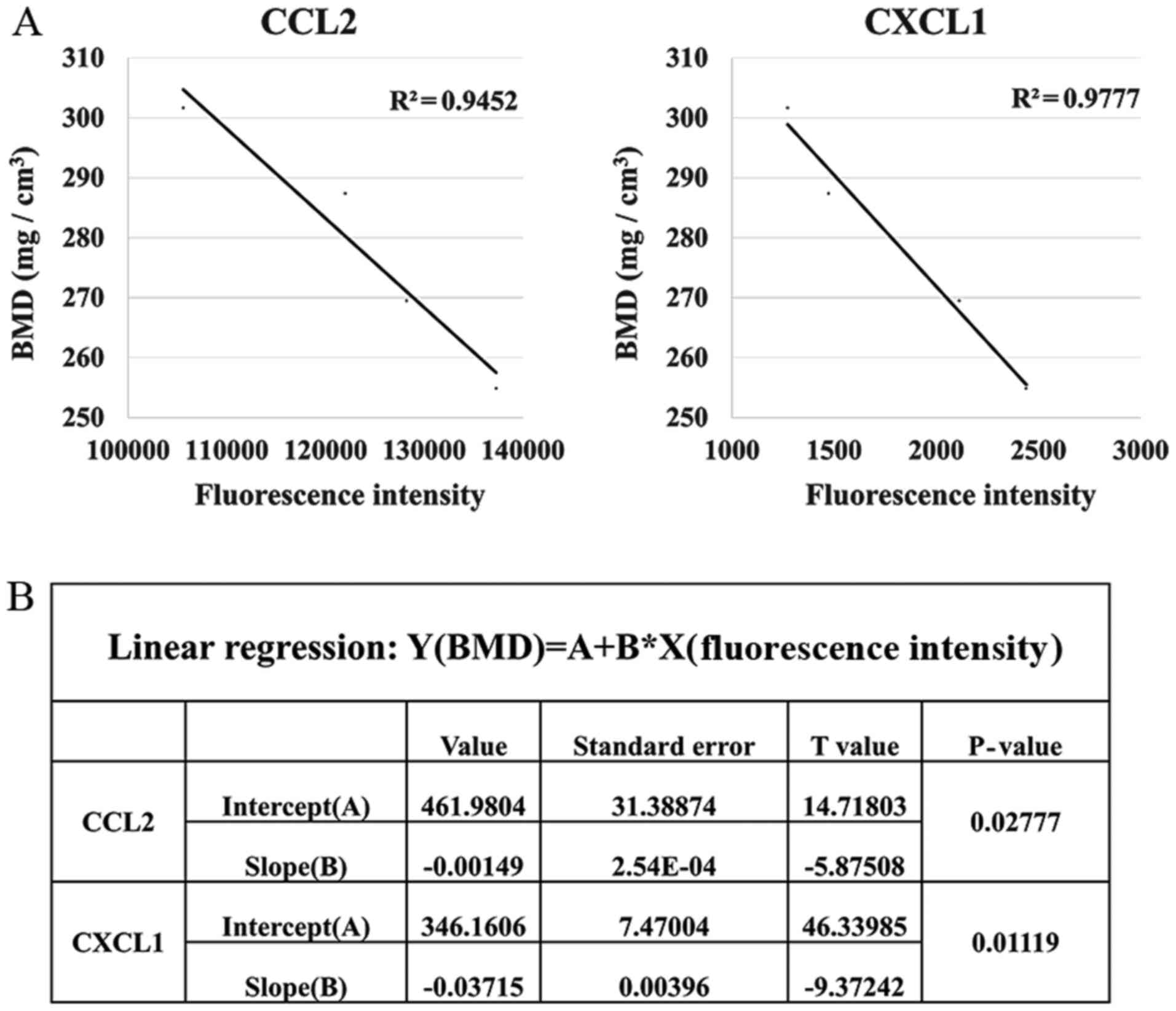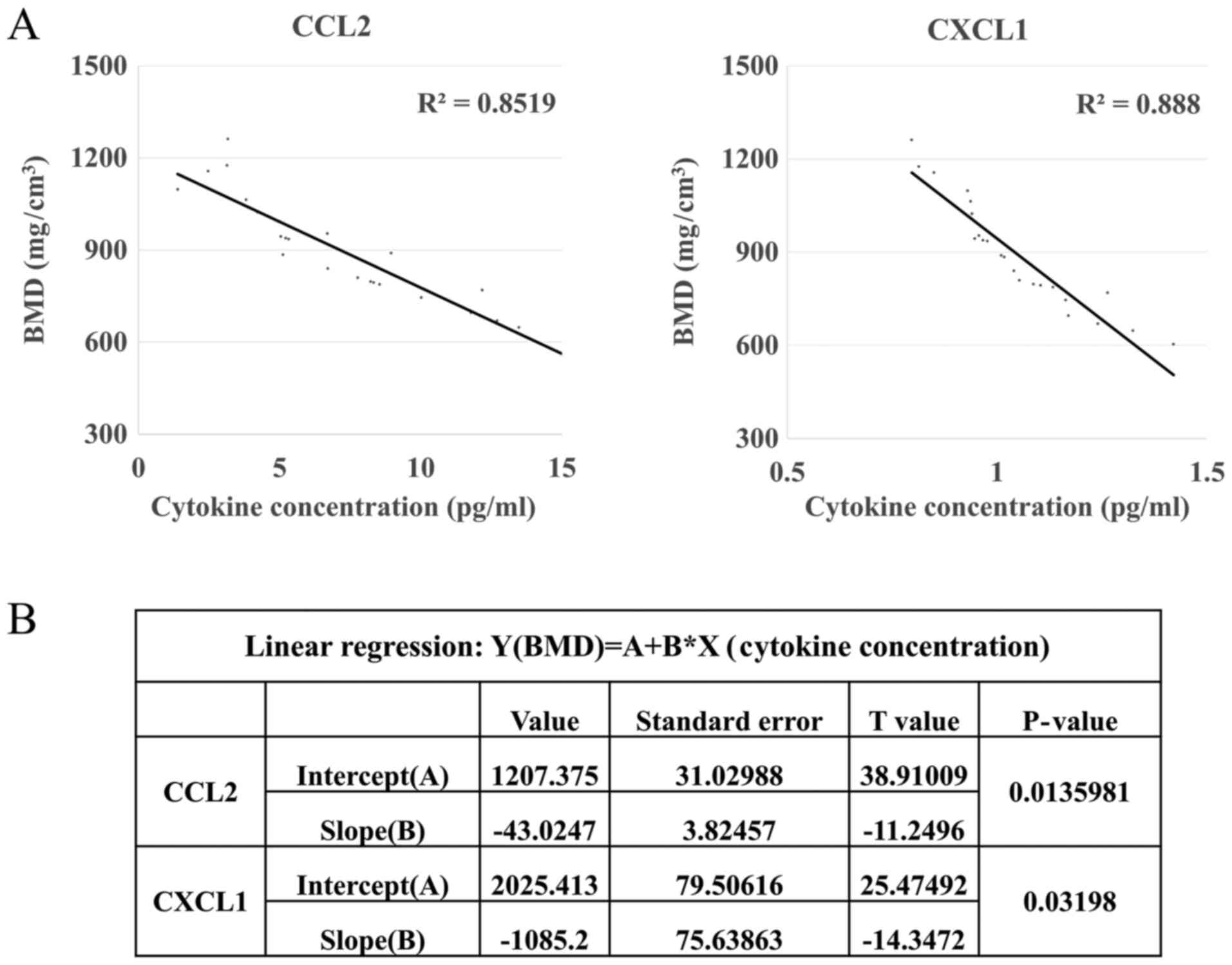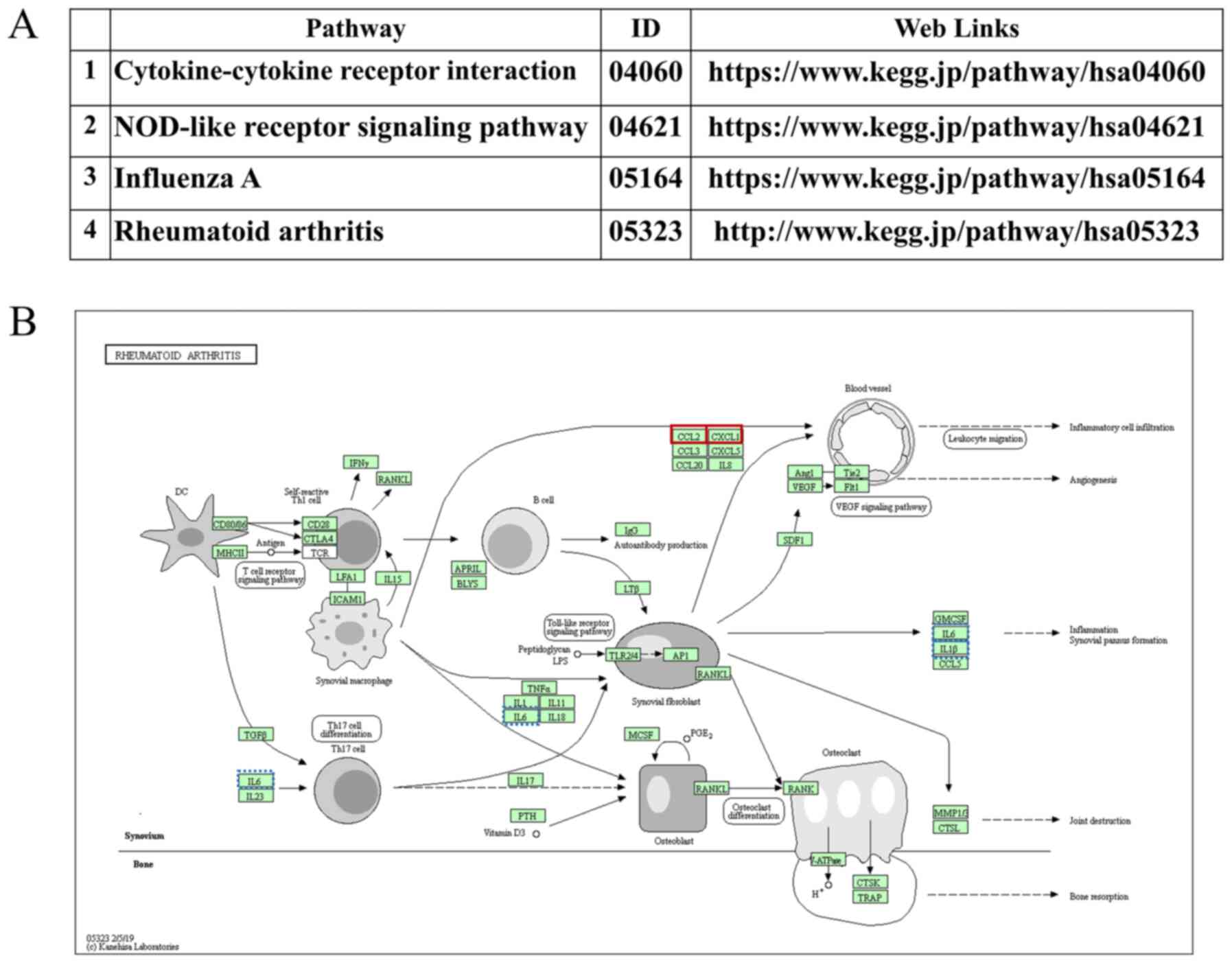|
1
|
López Picazo M, Humbert L, Di Gregorio S,
González Ballester MA and Del Río Barquero LM: Discrimination of
osteoporosis-related vertebral fractures by DXA-derived 3D
measurements: A retrospective case-control study. Osteoporosis Int.
30:1099–1110. 2019. View Article : Google Scholar
|
|
2
|
Gutierrez-Buey G, Restituto P, Botella S,
Monreal I, Colina I, Rodríguez-Fraile M, Calleja A and Varo N:
Trabecular bone score and bone remodelling markers identify
perimenopausal women at high risk of bone loss. Clin Endocrinol
(Oxf). 91:391–399. 2019. View Article : Google Scholar : PubMed/NCBI
|
|
3
|
Wang W, Huang CY, Wang ZP, Xu SS, Qian TY,
Chen YD and Wu WG: Serum C-C motif ligand 11/eotaxin-1 may serve as
a candidate biomarker for postmenopausal osteoporosis. J Med
Biochem. 38:353–360. 2019. View Article : Google Scholar : PubMed/NCBI
|
|
4
|
Eisenhauer A, Müller M, Heuser A, Kolevica
A, Glüer CC, Both M, Laue C, Hehn UV, Kloth S, Shroff R and
Schrezenmeir J: Calcium isotope ratios in blood and urine: A new
biomarker for the diagnosis of osteoporosis. Bone Rep.
10:1002002019. View Article : Google Scholar : PubMed/NCBI
|
|
5
|
Huang Y, Xie J and Li E: Comprehensive
circular RNA profiling reveals circ_0002060 as a potential
diagnostic biomarkers for osteoporosis. J Cell Biochem.
120:15688–15694. 2019. View Article : Google Scholar : PubMed/NCBI
|
|
6
|
Wang J, Yan D, Zhao A, Hou X, Zheng X,
Chen P, Bao Y and Jia W, Hu C, Zhang ZL and Jia W: Discovery of
potential biomarkers for osteoporosis using LC-MS/MS metabolomic
methods. Osteoporosis Int. 30:1491–1499. 2019. View Article : Google Scholar
|
|
7
|
Yang C, Ren J, Li B, Jin C, Ma C, Cheng C,
Sun Y and Shi X: Identification of gene biomarkers in patients with
postmenopausal osteoporosis. Mol Med Rep. 19:1065–1073.
2019.PubMed/NCBI
|
|
8
|
Haghighizadeh E, Shahrezaee M, Sharifzadeh
S and Momeni M: Transforming growth factor-β3 relation with
osteoporosis and osteoporotic fractures. J Res Med Sci. 24:462019.
View Article : Google Scholar : PubMed/NCBI
|
|
9
|
Arron JR and Choi Y: Bone versus immune
system. Nature. 408:535–536. 2000. View
Article : Google Scholar : PubMed/NCBI
|
|
10
|
Chao TH, Yu HN, Huang CC, Liu WS, Tsai YW
and Wu WT: Association of interleukin-1 beta (−511C/T)
polymorphisms with osteoporosis in postmenopausal women. Ann Saudi
Med. 30:437–441. 2010. View Article : Google Scholar : PubMed/NCBI
|
|
11
|
Wakabayashi H, Kato S, Nagao N, Miyamura
G, Naito Y and Sudo A: Interleukin-6 inhibitor suppresses
hyperalgesia without improvement in osteoporosis in a mouse pain
model of osteoporosis. Calcified Tissue Int. 104:658–666. 2019.
View Article : Google Scholar
|
|
12
|
Harmer D, Falank C and Reagan MR:
Interleukin-6 interweaves the bone marrow microenvironment, bone
loss, and multiple myeloma. Front Endocrinol (Lausanne). 9:7882018.
View Article : Google Scholar : PubMed/NCBI
|
|
13
|
Kim HJ, Kim HJ, Choi Y, Bae MK, Hwang DS,
Shin SH and Lee JY: Zoledronate enhances osteocyte-mediated
osteoclast differentiation by IL-6/RANKL axis. Int J Mol Sci.
20:14672019. View Article : Google Scholar
|
|
14
|
Edwards CJ and Williams E: The role of
interleukin-6 in rheumatoid arthritis-associated osteoporosis.
Osteoporosis Int. 21:1287–1293. 2010. View Article : Google Scholar
|
|
15
|
Blumenfeld O, Williams FMK, Valdes A, Hart
DJ, Malkin I, Spector TD and Livshits G: Association of
interleukin-6 gene polymorphisms with hand osteoarthritis and hand
osteoporosis. Cytokine. 69:94–101. 2014. View Article : Google Scholar : PubMed/NCBI
|
|
16
|
Tousen Y, Matsumoto Y, Nagahata Y,
Kobayashi I, Inoue M and Ishimi Y: Resistant starch attenuates bone
loss in ovariectomised mice by regulating the intestinal microbiota
and bone-marrow inflammation. Nutrients. 11:2972019. View Article : Google Scholar
|
|
17
|
Kotrych D, Dziedziejko V, Safranow K,
Sroczynski T, Staniszewska M, Juzyszyn Z and Pawlik A: TNF-α and
IL10 gene polymorphisms in women with postmenopausal osteoporosis.
Eur J Obstet Gynecol Reprod Biol. 199:92–95. 2016. View Article : Google Scholar : PubMed/NCBI
|
|
18
|
Ding Q, Zhou H, Yun B, Zhou L, Zhang N,
Yin G and Fan J: Interleukin-13 inhibits expression of cyp27b1 in
peripheral CD14+ cells that is correlated with vertebral bone
mineral density of patients with ulcerative colitis. J Cell
Biochem. 118:376–381. 2017. View Article : Google Scholar : PubMed/NCBI
|
|
19
|
Yang XW, Wang F, Qin RZ, Zhou QL and Huang
HX: Elevated serum CCL4/MIP-1β levels in postmenopausal
osteoporosis patients are linked with disease severity. Biomark
Med. 13:17–25. 2019. View Article : Google Scholar : PubMed/NCBI
|
|
20
|
Zheng J, Maerz W, Gergei I, Kleber M,
Drechsler C, Wanner C, Brandenburg V, Reppe S, Gautvik KM,
Medina-Gomez C, et al: Mendelian randomization analysis reveals a
causal influence of circulating sclerostin levels on bone mineral
density and fractures. J Bone Miner Res. 34:1824–1836. 2019.
View Article : Google Scholar : PubMed/NCBI
|
|
21
|
Wang W, Wang ZP, Huang CY, Chen YD, Yao WF
and Shi BM: The neuropeptide vasoactive intestinal peptide levels
in serum are inversely related to disease severity of
postmenopausal osteoporosis: A cross-sectional study. Genet Test
Mol Bioma. 23:480–486. 2019. View Article : Google Scholar
|
|
22
|
Vollherbst DF, Otto R, Do T, Kauczor HU,
Bendszus M, Sommer CM and Möhlenbruch MA: Imaging artifacts of Onyx
and PHIL on conventional CT, cone-beam CT and MRI in an animal
model. Interv Neuroradiol. 24:693–701. 2018. View Article : Google Scholar : PubMed/NCBI
|
|
23
|
Kanehisa M and Goto S: KEGG: Kyoto
encyclopedia of genes and genomes. Nucleic Acids Res. 28:27–30.
2000. View Article : Google Scholar : PubMed/NCBI
|
|
24
|
Kanehisa M, Sato Y, Furumichi M, Morishima
K and Tanabe M: New approach for understanding genome variations in
KEGG. Nucleic Acids Res. 47(D1): D590–D595. 2019. View Article : Google Scholar : PubMed/NCBI
|
|
25
|
Kanehisa M: Toward understanding the
origin and evolution of cellular organisms. Protein Sci.
28:1947–1951. 2019. View
Article : Google Scholar : PubMed/NCBI
|
|
26
|
Krause K, Sabat R, Witte Händel E, Schulze
A, Puhl V, Maurer M and Wolk K: Association of CCL2 with systemic
inflammation in Schnitzler syndrome. Br J Dermatol. 180:859–868.
2019. View Article : Google Scholar : PubMed/NCBI
|
|
27
|
Wang Y, Zhang X, Yang L, Xue J and Hu G:
Blockade of CCL2 enhances immunotherapeutic effect of anti-PD1 in
lung cancer. J Bone Oncol. 11:27–32. 2018. View Article : Google Scholar : PubMed/NCBI
|
|
28
|
Higashino N, Koma YI, Hosono M, Takase N,
Okamoto M, Kodaira H, Nishio M, Shigeoka M, Kakeji Y and Yokozaki
H: Fibroblast activation protein-positive fibroblasts promote tumor
progression through secretion of CCL2 and interleukin-6 in
esophageal squamous cell carcinoma. Lab Invest. 99:777–792. 2019.
View Article : Google Scholar : PubMed/NCBI
|
|
29
|
Shang Y, Tian L, Chen T, Liu X, Zhang J,
Liu D, Wei J, Fang W, Chen Y and Shang D: CXCL1 promotes the
proliferation of neural stem cells by stimulating the generation of
reactive oxygen species in APP/PS1 mice. Biochem Biophys Res
Commun. 515:201–206. 2019. View Article : Google Scholar : PubMed/NCBI
|
|
30
|
Salinas-Muñoz L, Campos-Fernández R,
Olivera-Valle I, Mercader E, Fernandez-Pacheco C, Lasarte S,
Pérez-Martín L, Navarro-González MT and Sánchez-Mateos: Estradiol
impairs epithelial CXCL1 gradient in the cervix to delay neutrophil
transepithelial migration during insemination. J Reprod Immunol.
132:9–15. 2019. View Article : Google Scholar : PubMed/NCBI
|
|
31
|
Manjavachi MN, Passos GF, Trevisan G,
Araújo SB, Pontes JP, Fernandes ES, Costa R and Calixto JB: Spinal
blockage of CXCL1 and its receptor CXCR2 inhibits
paclitaxel-induced peripheral neuropathy in mice.
Neuropharmacology. 151:136–143. 2019. View Article : Google Scholar : PubMed/NCBI
|
|
32
|
Zhang ZJ, Cao DL, Zhang X, Ji RR and Gao
YJ: Chemokine contribution to neuropathic pain: Respective
induction of CXCL1 and CXCR2 in spinal cord astrocytes and neurons.
Pain. 154:2185–2197. 2013. View Article : Google Scholar : PubMed/NCBI
|
|
33
|
Huh Y, Ji RR and Chen G:
Neuroinflammation, bone marrow stem cells, and chronic pain. Front
Immunol. 8:10142017. View Article : Google Scholar : PubMed/NCBI
|
|
34
|
Natoli R, Fernando N, Madigan M, Chu-Tan
JA, Valter K, Provis J and Rutar M: Microglia-derived IL-1β
promotes chemokine expression by Müller cells and RPE in focal
retinal degeneration. Mol Neurodegener. 12:312017. View Article : Google Scholar : PubMed/NCBI
|
|
35
|
Smirnov A, Pohlmann S, Nehring M, Ali S,
Mann-Nüttel R, Scheu S, Antoni AC, Hansen W, Büettner M, Gardiasch
MJ, et al: Sphingosine 1-phosphate- and C-C chemokine receptor
2-dependent activation of CD4+ plasmacytoid dendritic cells in the
bone marrow contributes to signs of sepsis-induced
immunosuppression. Front Immunol. 8:16222017. View Article : Google Scholar : PubMed/NCBI
|
|
36
|
Ma Z, Zhao X, Deng M, Huang Z, Wang J, Wu
Y, Cui D, Liu Y, Liu R and Ouyang G: Bone marrow mesenchymal
stromal cell-derived periostin promotes B-all progression by
modulating CCL2 in leukemia cells. Cell Rep. 26:1533–1543.e4. 2019.
View Article : Google Scholar : PubMed/NCBI
|
|
37
|
Hardaway AL, Herroon MK, Rajagurubandara E
and Podgorski I: Marrow adipocyte-derived CXCL1 and CXCL2
contribute to osteolysis in metastatic prostate cancer. Clin Exp
Metastasis. 32:353–368. 2015. View Article : Google Scholar : PubMed/NCBI
|
|
38
|
Di Munno O and Ferro F: The effect of
biologic agents on bone homeostasis in chronic inflammatory
rheumatic diseases. Clin Exp Rheumatol. 37:502–507. 2019.PubMed/NCBI
|
|
39
|
Lacativa PG and Farias ML: Osteoporosis
and inflammation. Arq Bras Endocrinol Metabol. 54:123–132. 2010.
View Article : Google Scholar : PubMed/NCBI
|
|
40
|
Mundy GR: Osteoporosis and inflammation.
Nutr Rev. 65:S147–S151. 2007. View Article : Google Scholar : PubMed/NCBI
|
|
41
|
Babu H, Ambikan AT, Gabriel EE, Svensson
Akusjärvi S, Palaniappan AN, Sundaraj V, Mupanni NR, Sperk M,
Cheedarla N, Sridhar R, et al: Systemic inflammation and the
increased risk of inflamm-aging and age-associated diseases in
people living with HIV on long term suppressive antiretroviral
therapy. Front Immunol. 10:19652019. View Article : Google Scholar : PubMed/NCBI
|
|
42
|
Ke JY, Kliewer KL, Hamad EM, Cole RM,
Powell KA, Andridge RR, Straka SR, Yee LD and Belury MA: The
flavonoid, naringenin, decreases adipose tissue mass and attenuates
ovariectomy-associated metabolic disturbances in mice. Nutr Metab
(Lond). 12:12015. View Article : Google Scholar : PubMed/NCBI
|
|
43
|
Siddiqui JA and Partridge NC:
CCL2/Monocyte chemoattractant protein 1 and parathyroid hormone
action on bone. Front Endocrinol (Lausanne). 8:492017. View Article : Google Scholar : PubMed/NCBI
|
|
44
|
Valerio MS, Herbert BA, Basilakos DS,
Browne C, Yu H and Kirkwood KL: Critical role of MKP-1 in
lipopolysaccharide-induced osteoclast formation through CXCL1 and
CXCL2. Cytokine. 71:71–80. 2015. View Article : Google Scholar : PubMed/NCBI
|
|
45
|
Khan UA, Hashimi SM, Bakr MM, Forwood MR
and Morrison NA: CCL2 and CCR2 are essential for the formation of
osteoclasts and foreign body giant cells. J Cell Biochem.
117:382–389. 2016. View Article : Google Scholar : PubMed/NCBI
|
|
46
|
Chen W, Foo SS, Taylor A, Lulla A, Merits
A, Hueston L, Forwood MR, Walsh NC, Sims NA, Herrero LJ and
Mahalingam S: Bindarit, an inhibitor of monocyte chemotactic
protein synthesis, protects against bone loss induced by
chikungunya virus infection. J Virol. 89:581–593. 2015. View Article : Google Scholar : PubMed/NCBI
|
|
47
|
Ho-Le TP, Center JR, Eisman JA, Nguyen HT
and Nguyen TV: Prediction of bone mineral density and fragility
fracture by genetic profiling. J Bone Miner Res. 32:285–293. 2017.
View Article : Google Scholar : PubMed/NCBI
|
|
48
|
Ho-Le TP, Pham HM, Center JR, Eisman JA,
Nguyen HT and Nguyen TV: Prediction of changes in bone mineral
density in the elderly: Contribution of ‘osteogenomic profile’.
Arch Osteoporos. 13:682018. View Article : Google Scholar : PubMed/NCBI
|
|
49
|
Orwoll ES, Lapidus J, Wang PY, Vandenput
L, Hoffman A, Fink HA, Laughlin GA, Nethander M, Ljunggren Ö,
Kindmark A, et al: The limited clinical utility of testosterone,
estradiol, and sex hormone binding globulin measurements in the
prediction of fracture risk and bone loss in older men. J Bone
Miner Res. 32:633–640. 2017. View Article : Google Scholar : PubMed/NCBI
|















